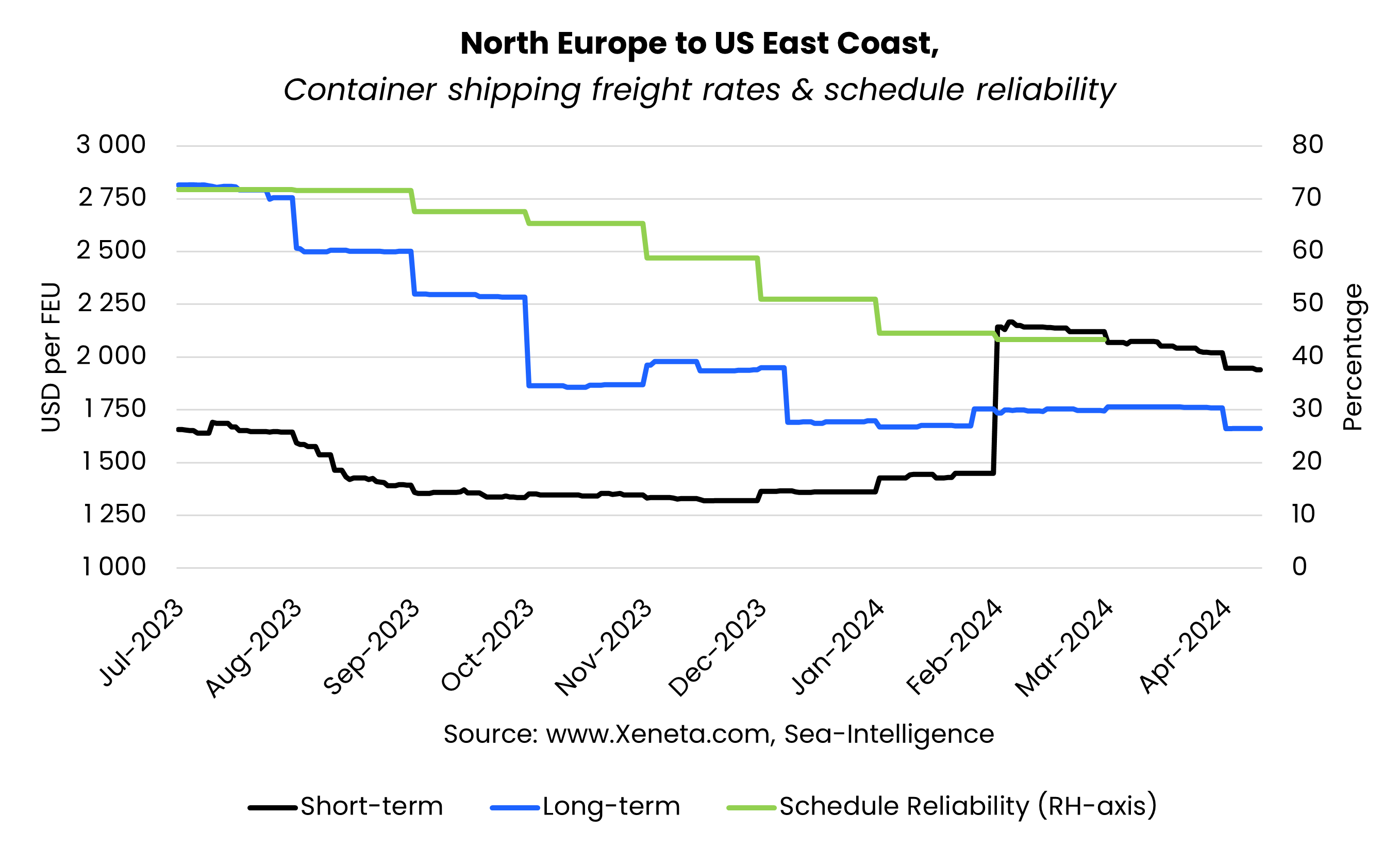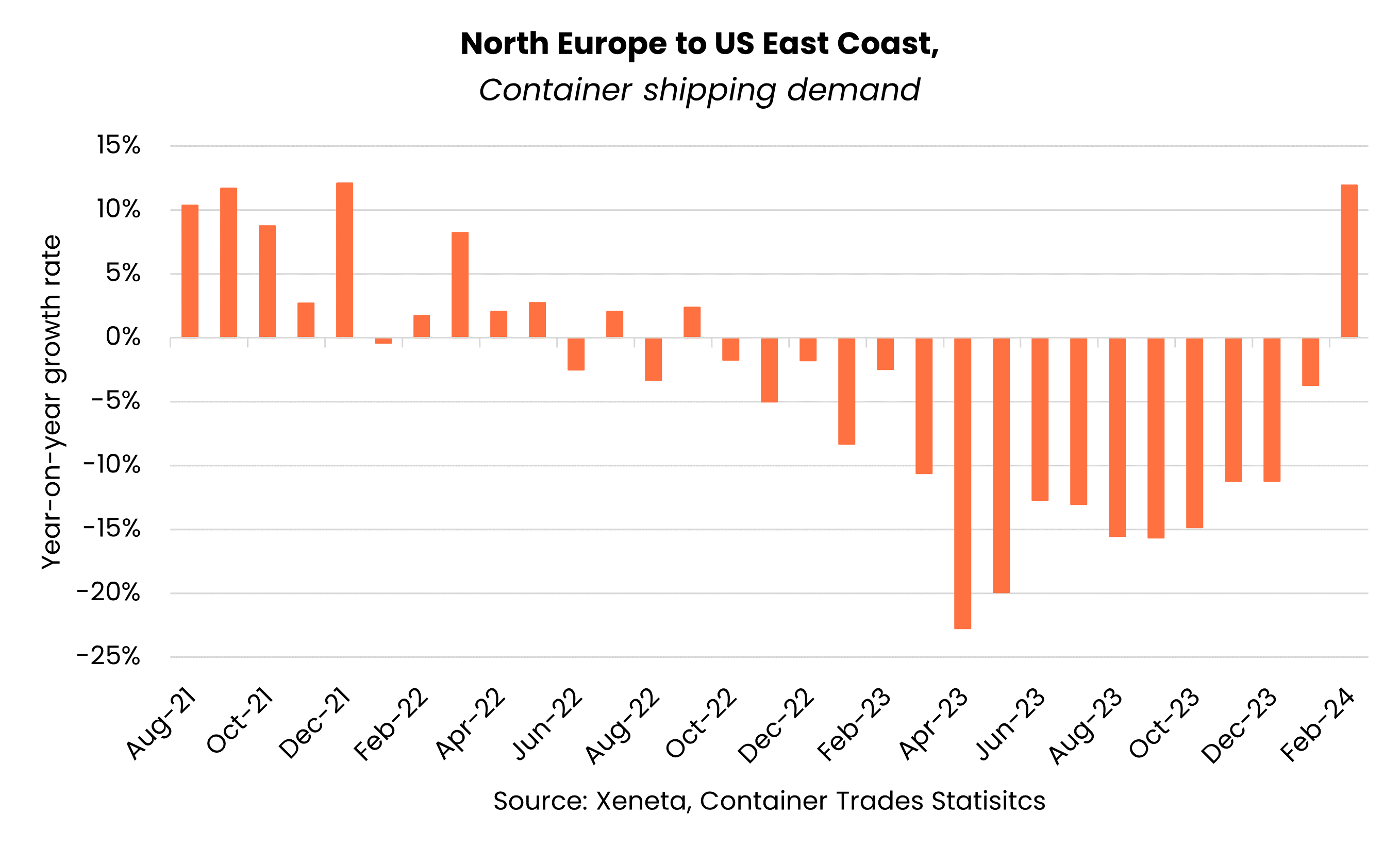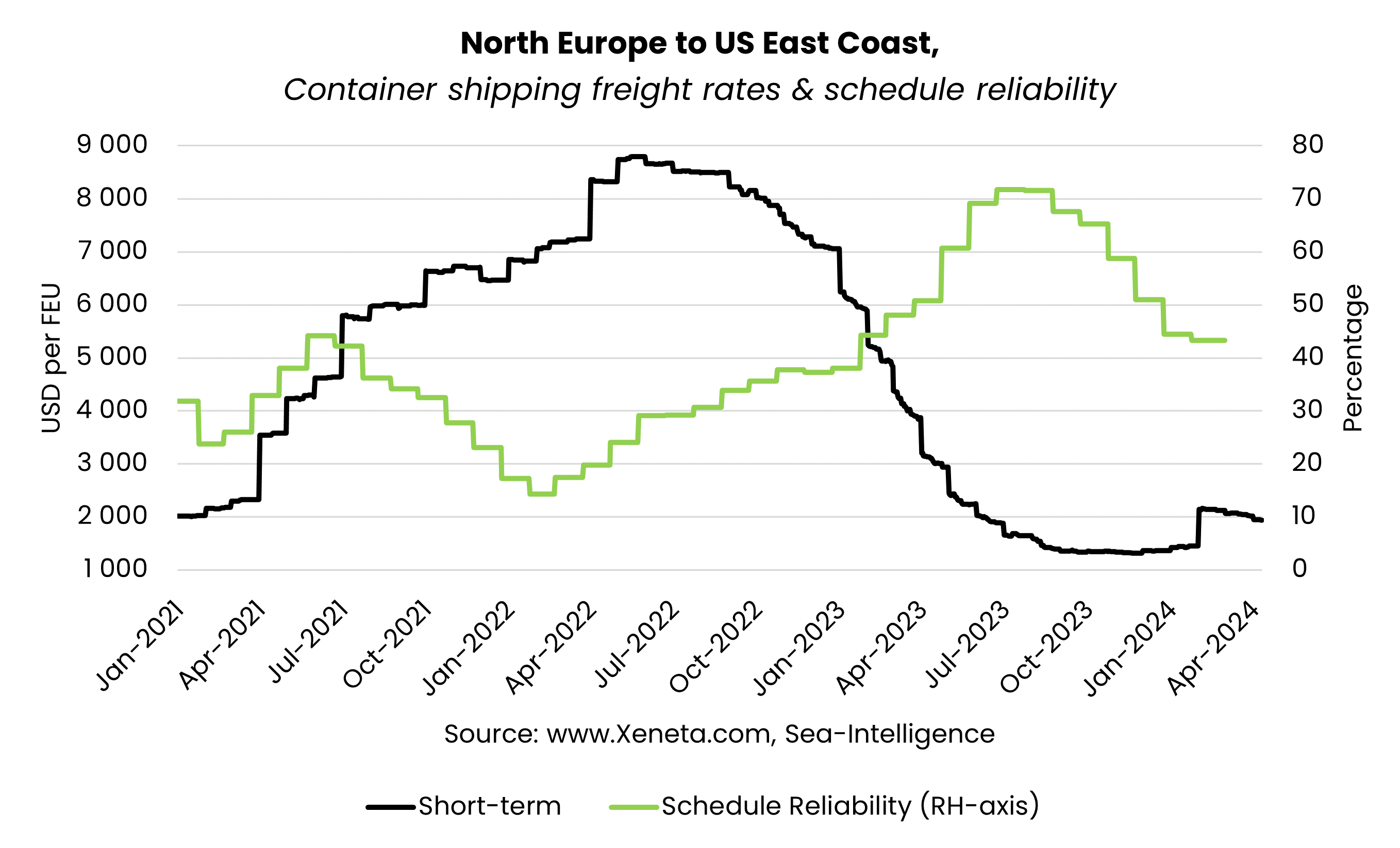The Transatlantic fronthaul from North Europe to the US East Coast has led a somewhat strange existence in the past 12 months, with a recent surge in spot rates only serving to add to the question marks hanging over it.
2023 was a year that saw the Transatlantic fronthaul market plunge, with average spot rates dropping from USD 6240 per FEU on 1 January to USD 1320 on 16 November. This all-time low point was hit just 18 months after the market reached an all-time high in May 2022.
This declining market was in part caused by the Transatlantic being used a dumping ground for capacity as carriers removed ships from other major trades in an effort to keep rates elevated on those more lucrative services.
By the start of December last year this had resulted in 18 consecutive months of declining spot rates and a trade which had seemingly been left to wither on the vine by carriers.
Then, in December, suddenly there were signs of life as the market saw minor increases in average spot rates. By the beginning of February these green shoots of recovery had grown into a surging market, with spot rates jumping by 48% at the turn of the month to hit a level not seen since May 2023.

The highs and lows of the short term market
From the peak in early February, rates have since declined by 10.5% (USD 228 per FEU). What could be causing such a volatile and unpredictable market?
Perhaps the escalation of conflict in the Red Sea in mid-December had a part to play in the rates increase, certainly it cannot be ruled out completely. The Transatlantic should not be impacted operationally by the situation in the Red Sea, but neither should the Transpacific trade into the US West Coast, yet both saw significant increases in spot rates, which peaked in early February (Transatlantic and Transpacific trades as well as Far East into US East Coast peaked around two weeks after trades from the Far East into Europe).
The reason being, carriers were removing capacity from Transpacific and Transatlantic trades to service the longer sailing distances around the Cape of Good Hope in Africa on trades from the Far East which could no longer transit the Suez Canal due to threat of missile attacks by Houthi militia.
The fact rates on the Transatlantic fronthaul have now fallen back below USD 2 000 per FEU may be an indication of an underlying weakness on this market. The overcapacity which haunted this trade during 2023 has not gone away, despite capacity being down by 8.5% when comparing the first 12 weeks of 2024 with the same period in 2023.
Even allowing for the situation in the Red Sea, oversupply is still prevalent on the Transatlantic and therefore it should not be surprising to witness the weakening market – the big question mark remaining is just how far rates will decrease before they flatten.
Confusion also reigns when it comes to the make-up of capacity on this trade.
Non-alliance capacity has fallen by 20% but still accounts for 30% of the total on this trade. 2M and Ocean Alliance have both made 10% cuts, whereas The Alliance (Hapag-Lloyd, Yang Ming, ONE and HMM) has added 11%. (source: Sea-Intelligence)
Record demand in February
Of course, capacity is only one side of the coin and we must also consider demand when it comes to factors impacting the cost of ocean freight shipping. Again, there has been some curious movements in this regard on the Transatlantic fronthaul.
February 2024 turned out to be the busiest February on record with 160,000 TEU being moved across the North Atlantic basin in the westbound direction, raising the prospect that the Red Sea conflict was not the only driver of rates increases on this trade.
Comparing the first two months of 2024 against the same period in 2023 reveals a combined growth of 4.2%. This is made all the more remarkable in the fact January 2024 was the weakest first month of the year since 2020. (source: Container Trades Statistics)
This strong lift in demand combined with a decisive GRI-push by carriers helped to drive the spot market surge but these higher rates have not stuck. It seems even record-breaking demand growth is not enough to balance the oversupply of capacity on this trade.
Long term market may be favoring shippers
The development of the long term market on the Transatlantic fronthaul is equally as curious as its short term counterpart.
Long term contract freight rates have been consistently falling since they reached a peak in August 2022 amid the market highs of Covid-19.
This has coincided with falling demand on this trade, with September 2022 being the last month in which demand recorded a year-on-year increase until February this year. That represents 16 consecutive months of year-on-year demand decreases.
The next question is obvious – is February’s year-on-year demand increase a false dawn or a genuine sign that volumes are ready to rise once more?
The long term contract market can be viewed as the real acid test, with shippers often being able to call the bluff of the spot market during negotiations.
We are now through March and past the first two months of the year which are usually off-season on the Transatlantic trade with lower volumes – yet spot rates are continuing to fall, which suggests it is a market which favors shippers during negotiations for new long term contracts.
We have already seen the average of long term contract rates on the Transatlantic fronthaul market fall by USD 100 per FEU (-5.2%) as March turned into April. If shippers are indeed winning the arm wrestle with freight forwarders and carriers during negotiations and calling their spot market bluff then we can expect them to secure more favorable long term agreements.

Service reliability – or lack of it – on the Transatlantic
Finally, the curiosity of the Transatlantic trade is rounded off by fluctuating service reliability (SR).
From a horrendous average SR of 14.3% exactly two years ago in February 2022, when the trade lane was marred by a variant of Covid-19, the situation improved dramatically to hit 71.7% and 71.6% in August and September 2023 respectively.
Reliability then began to fall again for no immediately apparent reason, reaching 51% in December 2023 before plumbing down to 43.3% in February of this year. All this has happened against the backdrop demand falling on this trade by 14% year-on-year during the second half of 2023.
Inconsistency seems to be the only constant on the Transatlantic fronthaul in recent times and that extends to reliability across carriers, with huge differences between them.
While the best performing carrier delivers a SR of 62.86% in February 2024, the worst performing offers its customers a SR of 0.00%. (source: Sea-intelligence)
Curiosity is set to prevail on this trade during 2024 as the markets continue to adjust and recalibrate at a global level.
The only way to satisfy your curiosity is through data. Will spot rates continue to fall? If so, how low can they go? Will shippers squeeze even lower long term rates? If so, where does that leave carriers’ financial performance which had already taken a turn for the worse in 2023.
The answers will be found on the Xeneta platform, with our customers able to access data and insights on a trade-by-trade level so they are ready to react and make evidence-based decisions on supply chains – no matter what the market throws up.






